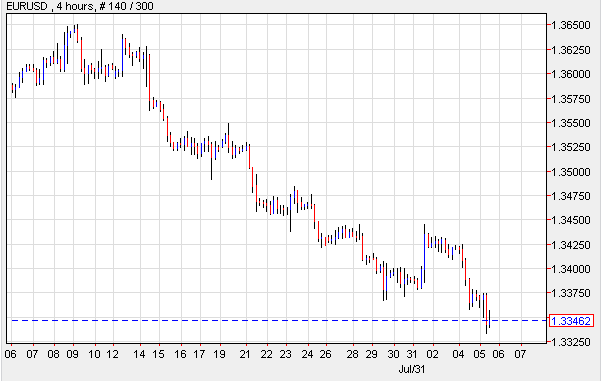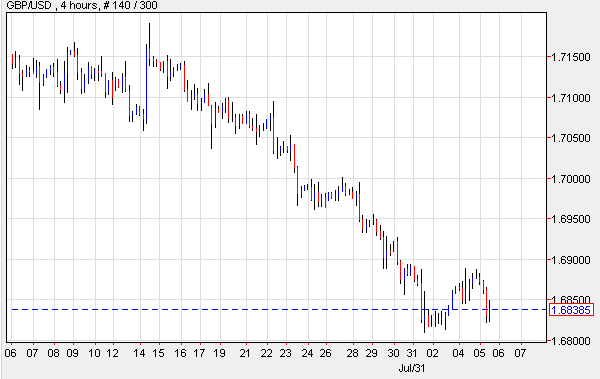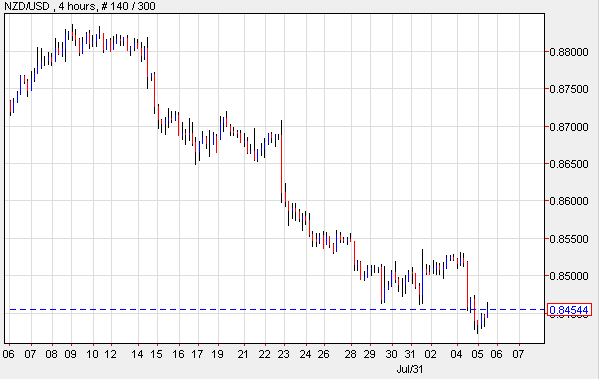The greenback climbed to the highest level in nine months against the Euro and strengthened versus several of its peers on signs that the U.S. economy is improving, and as tensions in the Ukraine bolstered appeal for U.S. assets. The U.S. Dollar surged versus most Forex counterparts after Richard Fisher, the President of the Federal Reserve Bank of Dallas, indicated that the monetary authorities are becoming more bullish. In other words, they're in consensus that there is a need to depart from the current accommodative policies that are debasing the currency. Demand for safety increased in the markets as Russian President, Vladimir Putin, mobilized more troops to the Ukraine border, indicating that the crisis could heat up at any moment. Furthermore, Mr. Putin pledged to levy sanctions against the West. In the U.S., Factory Orders went up 1.1 percent in the month of June, more than the predicted 0.5 percent. Other releases showed that the Services Purchasing Manager's Index climbed to 58.7 in July after coming in at 56.0 in the prior month. And lastly, the Commerce Department issued positive news, indicating that the Trade Deficit narrowed in the month of June as imports fell the most in twelve months, given that the country is becoming more energy independent. Official figures denoted that the gap narrowed from $44.7 to $41.5 billion. Oil Imports were at the lowest level since 2010, causing the U.S. Trade Deficit to contract.
Gold Prices jumped as some traders sought out the commodity due to the belief that was oversold. The shiny metal also benefitted from higher demand for safe assets, given recent signs that the tensions between Russia and the Ukraine could increase. Futures for delivery in December rose to $1,292.20 a troy ounce on the Comex, after hitting a low of $1,283.60. Releases issued on Wednesday reflected the weakness of the Euro-zone's economy, and led speculators to believe that the European Central Bank may have to expand stimulus to fight the deflationary pressures. Germany, the largest economy of the zone announced that Factory Orders fell, and Italy announced a decline in its Gross Domestic Product, suggesting that the country is now in a recession. The British Pound slumped versus the greenback after domestic news missed expectations, and Inflation forecasts dimmed subsequent to the announcement of the metrics. The Swiss Franc slipped versus its U.S. counterpart as demand for the latter remained high, and publications out of Switzerland revealed that Consumer Price Inflation slowed 0.4 percent in July, just as analysts anticipated. On a year-over-year basis, the Consumer Price Inflation stagnated. And with reports showing that Russia is mobilizing more troops closer to the border with Ukraine, many analysts believe that the situation may intensify, thereby prompting market traders to seek havens, which in turn benefitted the Yen.
The Australian Dollar rose, though its advance was limited as solid U.S. economic reports supported demand for the greenback. New Zealand's Dollar on the other hand declined. This came about after official news confirmed that the number of employed individuals climbed in the second quarter, though less than predicted. The release also confirmed that the Unemployment Rate fell. The Kiwi dipped to the lowest level in two months against its U.S. peer.
EUR/USD- Italy In A Recession
The EUR/USD plummeted to a nine-month low after disappointing economic reports out of the E.U. reignited worries over the stability of the region's recovery. Speculators are also concerned that the situation in the Ukraine could impact the global economies. The pair remained under pressure as official fundamentals revealed that the Euro region's economy shrank at an annual pace of 0.3 percent in the second quarter, failing to expand the predicted 0.1 percent. The economy contracted 0.4 percent in the initial three months of the year. Other reports out of Germany revealed that Factory Orders slumped 3.2 percent in June, and on a year-over year basis, they fell 4.3 percent. Lastly, Italy, indicated that its Gross Domestic Product shrank 0.2 percent, while analysts had predicted the economy would expand by 0.2 percent. With Italy entering into a recession, and the data disappointing the markets, investors predict that the European Central Bank may have to take the necessary steps to ensure growth. However, most traders don't expect to see changes in the key cash rate; and they believe that if Mario Draghi, the ECB's President issues dovish comments, the EUR/USD could plummet further to the downside.

GBP/USD- Inflation Expectations Drop
The GBP/USD weakened, subsequent to a publication by the Office for National Statistics revealing that Industrial Output climbed 0.3 percent in June, but not the forecast 0.6 percent. Furthermore, Industrial Production went up 1.2 percent on a yearly basis, failing to jump the predicted 1.5 percent. And lastly, Manufacturing climbed 0.3 percent in June, subsequent to a decline of 1.3 percent in May, but missing predictions for a surge of 0.6 percent. The GBP/USD traded at the lowest rate in eight weeks as British bonds fell to the lowest level in twelve months on worries that the U.K.'s economy has lost momentum. Other sources revealed that shop prices slipped by the most on record in July. The announcement divulged that store prices went down an annual 1.9 percent, the maximum since 2006. This prompted the Inflation Expectation gauge for the next ten years to slump to the lowest level since the beginning of 2013. The British Retail Consortium said that the recovery of the British economy has caused the GBP/USD to rally 11 percent in the past year. However, economists predict that the currency pair could stay on a downward trend given the fact that economic releases have failed to meet expectations.

NZD/USD- Unemployment Falls
The NZD/USD touched a two-month low after official domestic releases out of the South Pacific nation divulged that the number of employed persons climbed 0.4 percent in the months of April to June, not the 0.7 percent economists expected. The announcement also indicated that the level of Unemployment inched down from 6.0 to 5.6 percent. According to the NZ Household Labor Force Survey conducted in June, the number of individuals out of work went up by 10,000. The pair has remained weak due to the drop in commodity prices and a pause in key cash rate increases.

USD/JPY- Market Jitters Boost Yen
The USD/JPY dipped as demand for harbor currencies supported the Yen's rally. The USD/JPY's dip came about after NATO indicated that there is a chance that Russia may not be telling the truth when it says that its intention is to send troops to the Ukraine for humanitarian reasons. Mr. Putin has not indicated that he will back down, and has continued building up the military presence in the border with Ukraine. There were no economic releases out of Japan as investors awaited the policy decision from the central bank.

Today's Outlook Today's economic calendar shows that the Euro region will issue the Interest Rate Decision, and the ECB's Press Conference. The U.S. will report on Initial and Continuing Jobless Claims. Japan will publish Adjusted Current Account Data as well as the Current account and the Interest Rate Decision. Australia will provide metrics on Home Loans and the RBA Monetary Policy Statement. And China will announce Exports, Imports and the Trade Balance.
